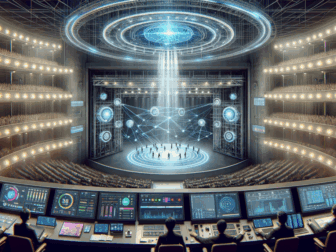Tag - Integration of Stage Art
Blog , February 8, 2024 , Future of IoT, Integration of Stage Art, Intelligent Lighting, Intelligent Stage, internet of things, iot, IoT technology, Performance System, Real-time Monitoring
Exploring the Synergy: Mastering the Integration of Stage Art in Modern Performances
Exploring the Synergy: Mastering the Integration of Stage Art in Modern Performances
The integration of stage art into theatrical and performance arts is a practice that has revolutionized the way audiences experience live shows. Stage art is not merely a background for actors to say their lines; it has become an integral part of storytelling, influencing the mood, theme, and overall reception of the production. This seamless blending of visual artistry with performance brings forth a sensory-rich experience that can transport audiences to different worlds, times, and states of mind.
At its core, the integration of stage art involves a dynamic collaboration between directors, set designers, lighting technicians, costume designers, and performers. Each element must work in concert to create a cohesive and compelling narrative. The set design provides the spatial canvas, setting the tone and environment in which the story unfolds. Modern advancements in technology have allowed for elaborate and adaptive set pieces, which can morph and change in real time, offering a fluid backdrop that responds to the action on stage.
Lighting design plays a pivotal role in this integration. It highlights key moments, directs the audience’s attention, and sets the emotional tone through color, intensity, and movement. The interplay of light and shadow can be as expressive as the story itself, creating moments of tension, serenity, or awe without a single word spoken.
Costume design, while often overshadowed by its more grandiose counterparts, is equally vital to the integration of stage art. Costumes reflect the characters’ personalities, status, and evolution throughout the performance. They serve as visual cues that enhance the narrative and can even interact with the set and lighting to create stunning visual effects, such as changes in appearance under different lighting conditions.
Moreover, the advent of digital projection and multimedia elements has opened up new vistas for stage art. Video projections can create dynamic backgrounds or display abstract visuals that complement the narrative. These digital elements, when used judiciously, can deepen the immersive quality of the performance and bridge the gap between traditional stagecraft and contemporary audiences accustomed to the digital world.
Sound design, though not visual, contributes significantly to the integration of stage art. The soundscape of a performance can drive the narrative forward, create an atmosphere, or provide emotional subtext. When the auditory and visual elements are in harmony, the impact on the audience is profound.
The integration of stage art is also a testament to the evolution of audience expectations. Today’s audiences are more visually literate and expect a multi-dimensional experience when they attend a performance. The synergistic blend of visual and performing arts meets this demand, providing a rich tapestry that engages multiple senses.
However, the successful integration of stage art is not without its challenges. It requires a delicate balance; the visual elements must support, not overshadow, the narrative and the performances. When done correctly, it enhances the storytelling, but when overdone, it can distract from the essence of the piece.
In conclusion, the integration of stage art in modern performances is an art form in itself. It demands creativity, technological savvy, and a profound understanding of how visual elements can be woven into the narrative fabric of a play or performance. As technology and artistic techniques continue to evolve, the potential for innovative and breathtaking integrations of stage art seems limitless. By remaining receptive to new ideas and collaborative opportunities, the world of stage art will continue to enthrall and inspire audiences for generations to come.
